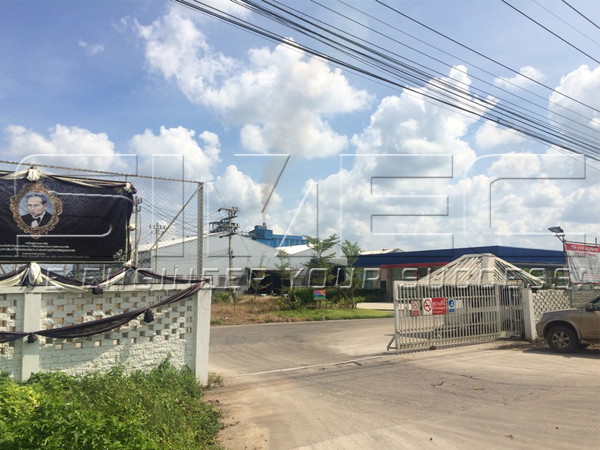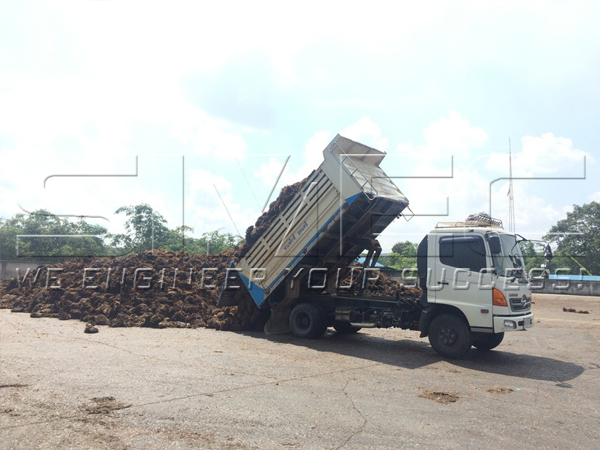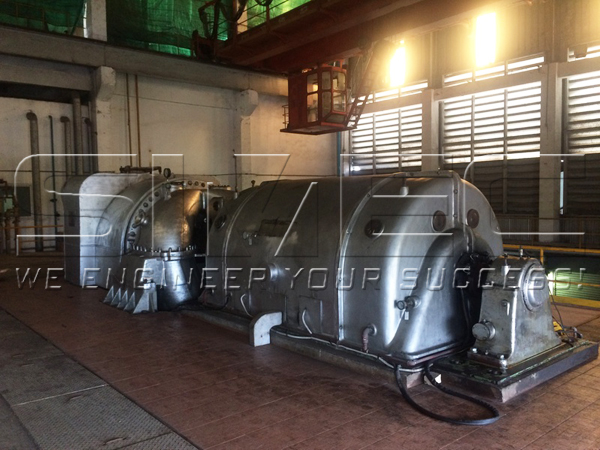Applications of Palm EFB in Biomass Power Plant
At the beginning of January, we were invited to visit a client’s factory which is located in Krabi, Thailand to make onsite investigation and scheme on how to replace their failed machines by SIMEC machines. The factory consists of two power plants: One is a 10MW Biomass Power Plant, raw materials is Pressed and Chopped Palm EFB; the other is a 2.4MW Biogas Power Plant, raw material is waste liquid which is generated by EFB pressing and EFB combustion. So the waste liquid from 10MW power plant is also utilized to generate power.

Main Entrance Of Client's Factory

10MW Biomass Power Plant
The entire process of this 10MW biomass power plant includes two major parts: Palm EFB Pressing & Chopping System and Power Generation System. Raw EFB materials are collected from Palm Oil Mills and being treated to be suitable fuel for power generation.

Unloading of Palm EFB from Oil Mills

EFB Presser and Chopping Machine
After being pressed and chopped, moisture content of EFB fiber will be reduced to around 50%, and the fiber length is less than 10cm. Then, treated EFB fiber will be fed into biomass steam boiler as fuel. Such treatment will promote the combustion efficiency.
The machine in red & black color was from local supplier in Thailand, it failed to chop EFB into short fibers because of its unreasonable design and mismatched technology.
SIMEC Palm EFB Chopping Machine will replace the failed machine as per client’s request.

Primary EFB Fuel and Biomass Steam Boiler
The power generation system mainly includes steam boiler, steam turbine and electric generator. Treated EFB is efficiently burned inside the combustion chamber of steam boiler, and generating steam to drive steam turbine and electric generator. Electric power is being generated continuously in this way.

Electricity Generation Unit

Condenser of Steam Turbine
Since treated EFB fuel still has 50% moisture content, waste liquid is also generated during combustion in steam boiler. The waste liquid is then being taken as raw material for the 2.4MW biogas power plant.
Some solid material is also discharged by the boiler. Such material is mainly unburned EFB fuel, so it still has calorific value and will be recycled to burn again. About 10% unburned EFB fuel of total will be generated from their existing boiler.
Actually, SIMEC has technology and solution to dry their EFB fuel before being fed into boiler. Moisture content of EFB fuel could be directly reduced to around 15%-20%. This will improve combustion efficiency and greatly reduce the amount of unburned fuel. Waste heat & flue gas from power plant can be utilized as heat source for dryer.
Boiler dry ash is collected and sold to farmers nearby as raw material for fertilizer.
Most waste materials can be reused again by next process or in other purpose. So their two plants maximize the utilization of resources. It’s a truly positive cycle to environment protection.

Solid Material Discharged by Boiler

Gasification Tank and Cooling Tower
Byproduct from biogas power plant includes sludge and waste water. After sewage treatment, the water will be clean and can be discharged directly. The sludge will be sold as fertilizer to farmers nearby.
However, there are several parts which need to be improved.
The first one is that the thermal efficiency of raw EFB is still low, around 2400 kcal/kg. Furthermore, due to high moisture content, there are 10% EFB that may not burn completely.
Beside drying EFB fiber onsite to reduce moisture content, our client is also considering to adopt SIMEC technology and make palm EFB pellets. SIMEC has already built several complete Palm EFB Pellet Plants. Another reason which promotes our client decide to make EFB pellets is about the storage area and safety. The EFB after chopping is fluffy and take a lot room for storage. And during hot seasons, the pile should be turned over frequently to avoid temperature increasing rapidly inside and catching fire. However, EFB pellets wipe out these situations by own characteristics. And it’s much easier for long-distance delivery and exporting.
The second part for improving is increasing chopping performance against raw EFB. Right now, we have signed contract that SIMEC will supply Palm EFB Chopping Machine to replace their existing machine whose performance is not good. Also the existing machine shakes in cycles during work.

2.4MW Gasification Power Generation Unit

Compare: Chopped EFB Fiber of Former Machine and SIMEC Machine
As we know, smaller size of fuel is helpful to improve the combustion efficiency. SIMEC is able to help them upgrade their exist equipment to process EFB into small fibers evenly in high output capacity.
SIMEC can also offer complete solution for making palm EFB pellets from waste raw EFB. Plant design will be customized based on project analysis and clients’ requirements. Our work aims to engineer clients’ successful project and business!
Main Entrance Of Client's Factory

10MW Biomass Power Plant
The entire process of this 10MW biomass power plant includes two major parts: Palm EFB Pressing & Chopping System and Power Generation System. Raw EFB materials are collected from Palm Oil Mills and being treated to be suitable fuel for power generation.

Unloading of Palm EFB from Oil Mills

EFB Presser and Chopping Machine
After being pressed and chopped, moisture content of EFB fiber will be reduced to around 50%, and the fiber length is less than 10cm. Then, treated EFB fiber will be fed into biomass steam boiler as fuel. Such treatment will promote the combustion efficiency.
The machine in red & black color was from local supplier in Thailand, it failed to chop EFB into short fibers because of its unreasonable design and mismatched technology.
SIMEC Palm EFB Chopping Machine will replace the failed machine as per client’s request.

Primary EFB Fuel and Biomass Steam Boiler
The power generation system mainly includes steam boiler, steam turbine and electric generator. Treated EFB is efficiently burned inside the combustion chamber of steam boiler, and generating steam to drive steam turbine and electric generator. Electric power is being generated continuously in this way.

Electricity Generation Unit

Condenser of Steam Turbine
Since treated EFB fuel still has 50% moisture content, waste liquid is also generated during combustion in steam boiler. The waste liquid is then being taken as raw material for the 2.4MW biogas power plant.
Some solid material is also discharged by the boiler. Such material is mainly unburned EFB fuel, so it still has calorific value and will be recycled to burn again. About 10% unburned EFB fuel of total will be generated from their existing boiler.
Actually, SIMEC has technology and solution to dry their EFB fuel before being fed into boiler. Moisture content of EFB fuel could be directly reduced to around 15%-20%. This will improve combustion efficiency and greatly reduce the amount of unburned fuel. Waste heat & flue gas from power plant can be utilized as heat source for dryer.
Boiler dry ash is collected and sold to farmers nearby as raw material for fertilizer.
Most waste materials can be reused again by next process or in other purpose. So their two plants maximize the utilization of resources. It’s a truly positive cycle to environment protection.

Solid Material Discharged by Boiler

Gasification Tank and Cooling Tower
Byproduct from biogas power plant includes sludge and waste water. After sewage treatment, the water will be clean and can be discharged directly. The sludge will be sold as fertilizer to farmers nearby.
However, there are several parts which need to be improved.
The first one is that the thermal efficiency of raw EFB is still low, around 2400 kcal/kg. Furthermore, due to high moisture content, there are 10% EFB that may not burn completely.
Beside drying EFB fiber onsite to reduce moisture content, our client is also considering to adopt SIMEC technology and make palm EFB pellets. SIMEC has already built several complete Palm EFB Pellet Plants. Another reason which promotes our client decide to make EFB pellets is about the storage area and safety. The EFB after chopping is fluffy and take a lot room for storage. And during hot seasons, the pile should be turned over frequently to avoid temperature increasing rapidly inside and catching fire. However, EFB pellets wipe out these situations by own characteristics. And it’s much easier for long-distance delivery and exporting.
The second part for improving is increasing chopping performance against raw EFB. Right now, we have signed contract that SIMEC will supply Palm EFB Chopping Machine to replace their existing machine whose performance is not good. Also the existing machine shakes in cycles during work.

2.4MW Gasification Power Generation Unit

Compare: Chopped EFB Fiber of Former Machine and SIMEC Machine
As we know, smaller size of fuel is helpful to improve the combustion efficiency. SIMEC is able to help them upgrade their exist equipment to process EFB into small fibers evenly in high output capacity.